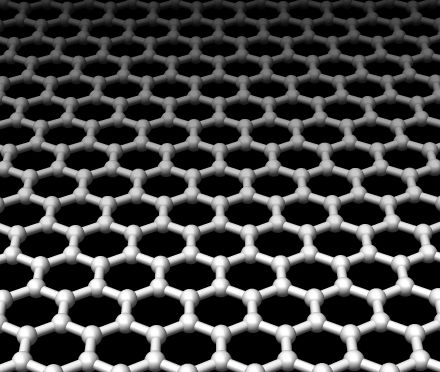Graphene looks set to take off in 2014, with applications in mobile devices and touch-screens. Mark Peplow explains...
Mark - One of the  things that's going to potentially be quite exciting this year is that we're actually going to start to see products that incorporate graphene on the market.
things that's going to potentially be quite exciting this year is that we're actually going to start to see products that incorporate graphene on the market.
Graphene is this 1-atom thick sheet of carbon arranged in a sort of hexagonal honeycomb pattern.
It was first isolated just 10 years ago and it's got some remarkable properties. It's stiff as diamond, hundreds of times stronger than steel weight for weight, but it's extremely flexible. Electrical charge travels through it much, much faster than other materials like silicon.
So, scientists have spent the last 20 years trying to investigate its properties and find uses for it.
There have been the old one or two very neat products on the market, but this year, we're being promised actual commercial devices. The first major one is likely to be touchscreens for Smartphones.
Chris - How does it work that's different from the silicon that we use at the moment or other similar materials of semiconductors we already have?
Mark - Well, let's look at a touchscreen. That's made out of something called indium tin oxide and it's electrode basically. So, when your finger touches it, it changes electrical current going through it and the device can sense where your finger is. That's why your phone knows where you're prodding it.
The key thing about indium tin oxide is it's transparent because you need to see the stuff going on underneath it that your phone is projecting. The trouble is, it's quite brittle and indium - the key ingredient in it - is increasingly rare, so it's getting more and more expensive.
Graphene potentially has the same properties and it's transparent and can conduct electricity very well. So, it could be a much more robust replacement. The key is going to be manufacturing it cheaply enough and at high enough quality.
Chris - When they were making graphene in the early days, they used to basically peel off bits with Cello tape from pencil leads and things. So presumably, they're not using that method to make sheets of graphene for mobile phones. They must've got this right now. How are they doing it?
Mark - That's how it was first isolated. Yeah, you literally take some graphite which is stacks of graphene, billions and billions of them all stacked like a huge sort of Shaggy and Scooby Doo sandwich. You just use sellotape to peel off the top layer. That is still the best way to give you the highest quality graphene.
Other larger scale manufacturing methods still can't make that quality. But the leading one is called chemical vapour disposition, basically use methane which is a gas and it's got carbon in it. You pip it over this copper foil. It's heated up to about a thousand degrees and that breaks down and forms these sort of sheets of graphene that slowly accumulate over it and then you very, very delicately peel it off and try and stick to whatever backing you need.
Chris - Who's making this and what are we going to see it in and when?
Mark - Well, the largest scale manufacturing operations over in China and it's remarkably difficult to actually get details about where they are with this. Samsung, the phone maker have already been showing around prototype devices that incorporate graphene touchscreens.
The big question is, can you make it good enough quality cheaply enough to make it a reasonable replacement? There's lots of industry watches saying that the prices are going to come down enough, the manufacturing is going to improve enough that it's going to happen this year. There's certainly a lot of Chinese companies that are making a lot of these stuff. So, we'll just have to wait and see.
Chris - Brilliant! Mark Peplow's prediction for 2014. Thank you very much, Mark.









Comments
Add a comment